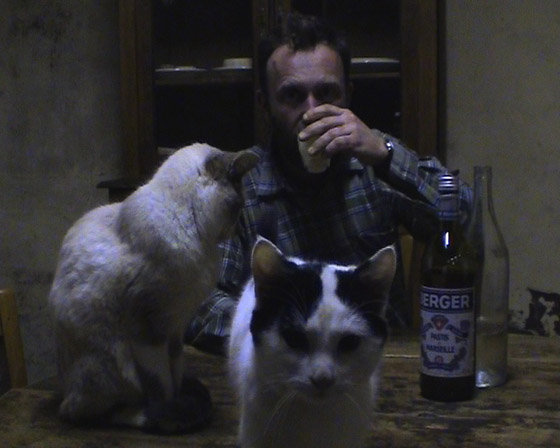The Decade in Review | Cyril Neyrat
If the films were classified in order of preference, In Vanda’s Room would occupy first place. It’s by chance that Costa’s film tops a chronological ordering: of the ten cited, it is undoubtedly the only one whose importance can be immediately measured against the scale of cinema history. In Vanda’s Room launched a new epoch, imposed a new barometer against which subsequent films would be measured, whether or not they chose to be. Saying so is not assuming that there is but one history of the cinema, a linear, unequivocal understanding of the art and its possibilities. On the contrary, the history of art is an anachronic tissue made of leaps, survivals, retakes (or reappearances), and the contemporaneity of several evolutions, which are sometimes contradictory. But if one must invent and imagine a history, then certain films distinguish themselves by their critical strength, in the double sense of “crisis” and “decision.” Within the dark light of In Vanda’s Room, all of the cinema from the ‘00s appears to be in crisis, divided between the repetition ad nauseam of old industrial and/or auteurist formulas, and the chance, that Costa indicates, of a path toward a new beginning.
This new beginning is paradoxical. It’s a return to the origin, but not a tabula rasa. The invention of a new primitivism, of a new elementary simplicity, without denying the legacy of a century of cinema and the arts. On the contrary, this history has blended in the very matter of the image, it survives like a ghost, it illuminates from afar like an original constellation—in opposition to quotation, detours, and other malicious and morbid games from the two previous decades. More than a return to the origin, it’s a return of the origin, of its native power.
Certainly the advent of digital filmmaking would have hastened this new beginning, making manifest the image’s plastic and material information, permitting new practices, upsetting the economy of films. There also, Costa is first to fully use digital shooting in order to reinvent, from a sumptuous poverty, a chronicle in small scale (In Vanda’s Room), and in epic scale (Colossal Youth, which like Où gît votre sourire enfoui? would have figured on the list if space was not needed for others).
Three other filmmakers displayed this impulse.
Jean-Claude Rousseau: His last and most beautiful film shot in Super 8, La Vallée close, was released in 2000, as if to pass the baton to Costa and to DV; eight years and numerous films later, De son appartement regains, in miniature and DV, the cosmological music of La Vallée close.
In Honor de cavalleria (2006), Albert Serra saves the honour of an epic tradition by cupping together Sancho’s earth and Quixote’s sky; burlesque and mystical, darkness and digital blow-outs.
Pierre Creton, finally, the least known of the three. FID Marseille was the first festival to show his films, and they showed them all. (While most festivals have merely maintained a cultural routine of international auteurism, FID was one of the rare ones, during the decade, to lead the way, to ask not what is current, but what is contemporary—as Agamben means it: “the real contemporary is one who does not perfectly coincide with its time, nor adheres to its pretentions, and defines himself, in this sense, as atemporal.) Rarely straying from his native Normandy, making his films alone, in DV, with the help of a few friends, Creton films what is closest at hand (his house, his neighbourhood, the peasants with whom he works, flowers, animals), finding in that which is furthest away (the cruelty of Bataille, Blanchot’s exhaustion, time lost and regained). In L’heure du Berger (2008), methods of waiting, of capturing the most minimal of events, are interwoven within mise en scènes ritualized through intimacy and friendship. As in Rousseau, an elemental eroticism governs the films, attracts and draws closer certain shots, the images and sounds, scattered, with open volumes and infinite resonances. A cinema of intimacy, but counterculture to today’s diary film, for which DV has opened the floodgates: objects of narcissism, navel-gazing, the “small affair,” as Deleuze used to say. The intimate, in Creton’s films, is never acquired: it only has worth because of what haunts it, and what makes and unmakes it.
The Brown Bunny, Death Proof, RR (2008): An American trilogy of the elementary, three films that rub up against the archaic and the modern to the point of creating sparks, alighting the final reels of celluloid.
Tropical Malady (2004): An origin regained of the tale and of belief.
The Sun (2005): Some of the most beautiful films of the decade were born of an ephemeral meeting: that of the digital and the photographic. Stemming from this anachronism, Sokurov changed the image of history.
Quei loro incontri (2006): “Only he who perceives in what is most modern and most recent, the signs or signature of archaism can be contemporary…In this sense, being contemporary signifies returning to a present where we’ve never been.” (Giorgio Agamben). In 2010, three years following the death of Danièle Huillet, Jean-Marie Straub remains the most contemporary of filmmakers.
Cyril Neyrat lives and films in Rome, teaches in Geneva, and writes in various places. He used to write for Cahiers du Cinéma and was the editor of Vertigo.
Translated by Andréa Picard.
Cyril Neyrat


